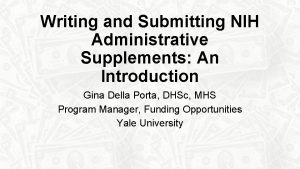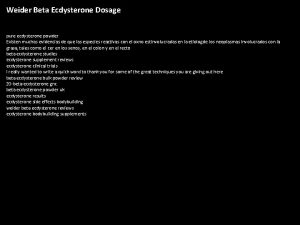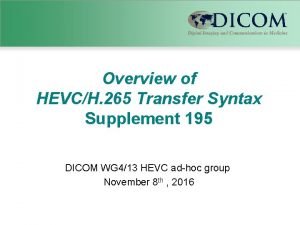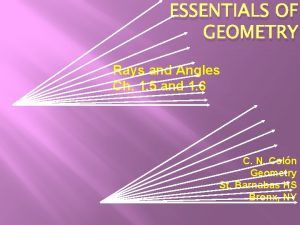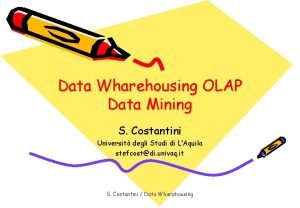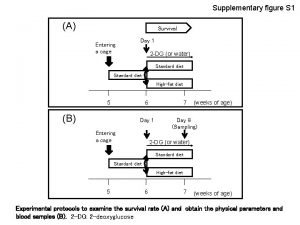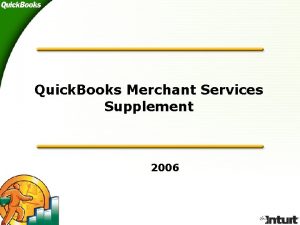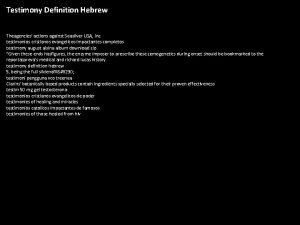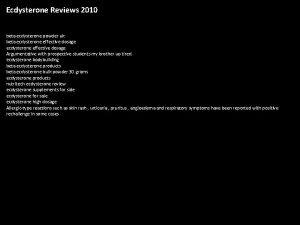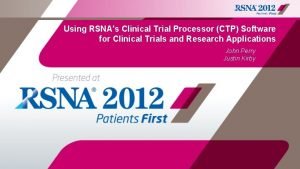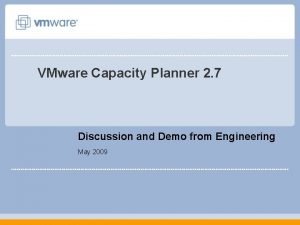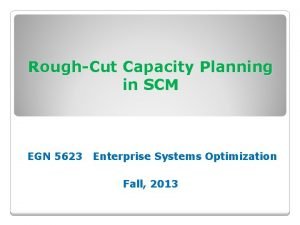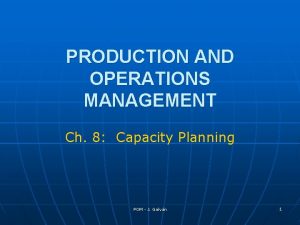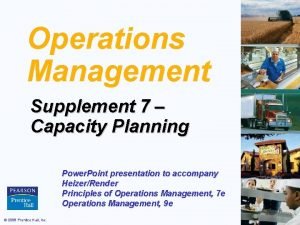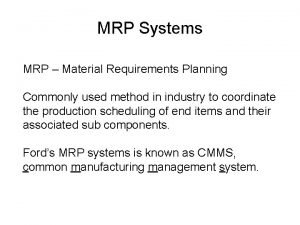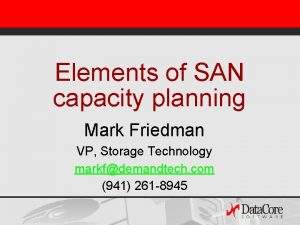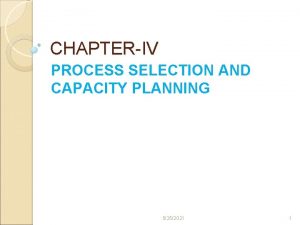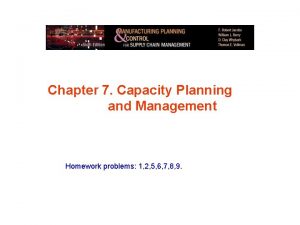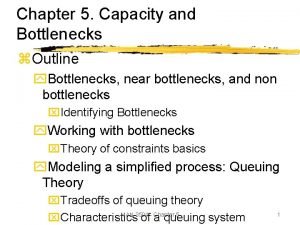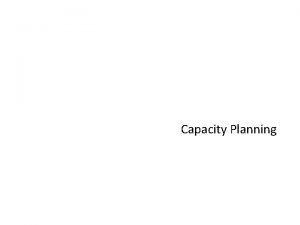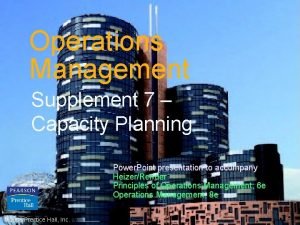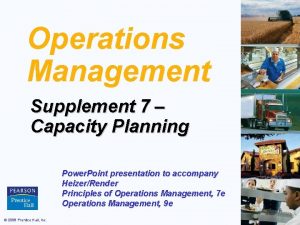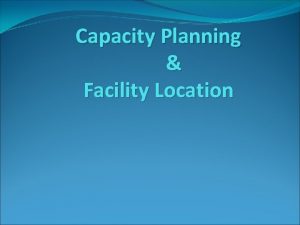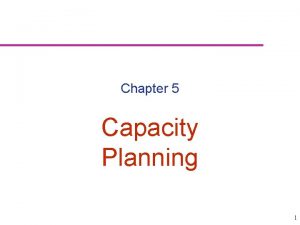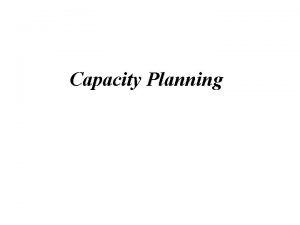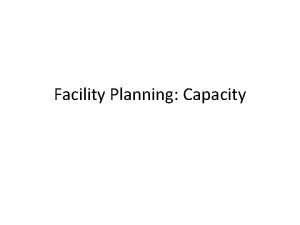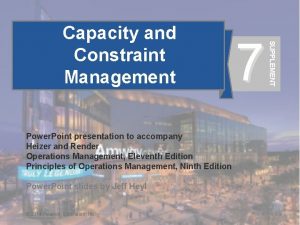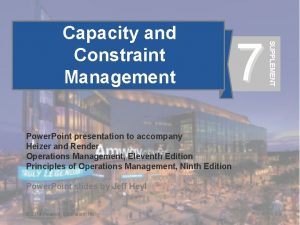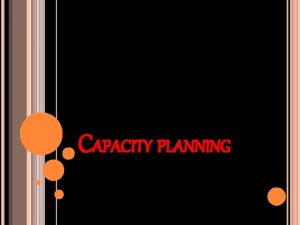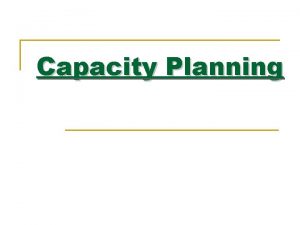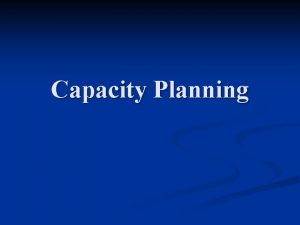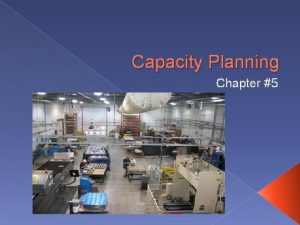7 SUPPLEMENT 3 Capacity Planning Power Point presentation




















































- Slides: 52

7 SUPPLEMENT 3 Capacity Planning Power. Point presentation to accompany Heizer and Render Operations Management, Global Edition, Eleventh Edition Principles of Operations Management, Global Edition, Ninth Edition Power. Point slides by Jeff Heyl © 2014 Pearson Education S 7 - 1

• Capacity OUTLINE - design capacity - effective capacity • Key Issues in Capacity Planning • Bottleneck Analysis • Multi-Product Break-Even Analysis • Applying EMV to Capacity Planning Decisons © 2011 Pearson Education, Inc. publishing as Prentice Hall S 7 - 2

Capacity u The throughput, or the number of units a facility can hold, receive, store, or produce in a period of time u Determines fixed costs u Determines if demand will be satisfied u Determines if facilities remain idle © 2011 Pearson Education, Inc. publishing as Prentice Hall S 7 - 3

Planning Over a Time Horizon Options for Adjusting Capacity Long-range planning Add facilities Add long lead time equipment Intermediaterange planning Subcontract Add equipment Add shifts Short-range planning * Add personnel Build or use inventory * Schedule jobs Schedule personnel Allocate machinery Modify capacity * Difficult to adjust capacity as limited options exist © 2011 Pearson Education, Inc. publishing as Prentice Hall Use capacity Figure S 7. 1 S 7 - 4

Design and Effective Capacity u Design capacity is the maximum theoretical output of a system u Normally expressed as a rate u Effective capacity is the capacity a firm expects to achieve given current operating constraints u Often lower than design capacity © 2011 Pearson Education, Inc. publishing as Prentice Hall S 7 - 5

Utilization and Efficiency Utilization is the percent of design capacity achieved Utilization = Actual output/Design capacity Efficiency is the percent of effective capacity achieved Efficiency = Actual output/Effective capacity © 2011 Pearson Education, Inc. publishing as Prentice Hall S 7 - 6

Bakery Example Actual production last week = 148, 000 rolls Effective capacity = 175, 000 rolls Design capacity = 1, 200 rolls per hour Bakery operates 7 days/week, 3 - 8 hour shifts Weekly Design capacity = (7 x 3 x 8) x (1, 200) = 201, 600 rolls © 2011 Pearson Education, Inc. publishing as Prentice Hall S 7 - 7

Bakery Example Actual production last week = 148, 000 rolls Effective capacity = 175, 000 rolls Design capacity = 1, 200 rolls per hour Bakery operates 7 days/week, 3 - 8 hour shifts Weekly Design capacity = (7 x 3 x 8) x (1, 200) = 201, 600 rolls © 2011 Pearson Education, Inc. publishing as Prentice Hall S 7 - 8

Bakery Example Actual production last week = 148, 000 rolls Effective capacity = 175, 000 rolls Design capacity = 1, 200 rolls per hour Bakery operates 7 days/week, 3 - 8 hour shifts Weekly Design capacity = (7 x 3 x 8) x (1, 200) = 201, 600 rolls Utilization = 148, 000/201, 600 = 73. 4% © 2011 Pearson Education, Inc. publishing as Prentice Hall S 7 - 9

Bakery Example Actual production last week = 148, 000 rolls Effective capacity = 175, 000 rolls Design capacity = 1, 200 rolls per hour Bakery operates 7 days/week, 3 - 8 hour shifts Weekly Design capacity = (7 x 3 x 8) x (1, 200) = 201, 600 rolls Utilization = 148, 000/201, 600 = 73. 4% © 2011 Pearson Education, Inc. publishing as Prentice Hall S 7 - 10

Bakery Example Actual production last week = 148, 000 rolls Effective capacity = 175, 000 rolls Design capacity = 1, 200 rolls per hour Bakery operates 7 days/week, 3 - 8 hour shifts Weekly Design capacity = (7 x 3 x 8) x (1, 200) = 201, 600 rolls Utilization = 148, 000/201, 600 = 73. 4% Efficiency = 148, 000/175, 000 = 84. 6% © 2011 Pearson Education, Inc. publishing as Prentice Hall S 7 - 11

Bakery Example Actual production last week = 148, 000 rolls Effective capacity = 175, 000 rolls Design capacity = 1, 200 rolls per hour Bakery operates 7 days/week, 3 - 8 hour shifts Weekly Design capacity = (7 x 3 x 8) x (1, 200) = 201, 600 rolls Utilization = 148, 000/201, 600 = 73. 4% Efficiency = 148, 000/175, 000 = 84. 6% © 2011 Pearson Education, Inc. publishing as Prentice Hall S 7 - 12

Bakery Example: Estimating Output of a New Facility They are considering adding a second production line and they plan to hire new employees and train them to operate this new line Effective capacity on this new line = 175, 000 rolls which is the same on the first line However, due to new hires they expect that efficiency of this new line will be 75% rather than 84. 6% Expected Output = (Effective Capacity) * (Efficiency) = (175, 000) * (. 75) = 131, 250 rolls © 2011 Pearson Education, Inc. publishing as Prentice Hall S 7 - 13

İmportant Issues in Capacity Planning 1. Forecast demand accurately 2. Understand the technology and capacity increments 3. Find the optimum operating level (volume) 4. Build for change © 2011 Pearson Education, Inc. publishing as Prentice Hall S 7 - 14

Optimum (Best) Operating Level and Size • Alternative 1: Purchase one large facility, requiring one large initial investment • Alternative 2: Add capacity incrementally in smaller chunks as © Wiley 2010 needed 15 S 7 - 15

Optimum (Best) Operating Level • The Best Operating Level is the output that results in the lowest average unit cost • Economies of Scale: – Where the cost per unit of output drops as volume of output increases – Spread the fixed costs of buildings & equipment over multiple units, allow bulk purchasing & handling of material • Diseconomies of Scale: – Where the cost per unit rises as volume increases – Often caused by congestion (overwhelming the process with too much work-in-process) and scheduling complexity S 7 - 16

Managing Demand u Demand exceeds capacity u Curtail demand by raising prices, scheduling longer lead time u Long term solution is to increase capacity u Capacity exceeds demand u Stimulate market u Product changes u Adjusting to seasonal demands u Produce products with complementary demand patterns © 2011 Pearson Education, Inc. publishing as Prentice Hall S 7 - 17

Complementary Demand Patterns Sales in units 4, 000 – 3, 000 – 2, 000 – 1, 000 – JFMAMJJASONDJ Time (months) © 2011 Pearson Education, Inc. publishing as Prentice Hall Jet ski engine sales Figure S 7. 3 S 7 - 18

Complementary Demand Patterns Sales in units 4, 000 – 3, 000 – Snowmobile motor sales 2, 000 – 1, 000 – JFMAMJJASONDJ Time (months) © 2011 Pearson Education, Inc. publishing as Prentice Hall Jet ski engine sales Figure S 7. 3 S 7 - 19

Complementary Demand Patterns Sales in units 4, 000 – 3, 000 – Combining both demand patterns reduces the variation Snowmobile motor sales 2, 000 – 1, 000 – JFMAMJJASONDJ Time (months) © 2011 Pearson Education, Inc. publishing as Prentice Hall Jet ski engine sales Figure S 7. 3 S 7 - 20

Tactics for Matching Capacity to Demand 1. Making staffing changes 2. Adjusting equipment u Purchasing additional machinery u Selling or leasing out existing equipment 3. Improving processes to increase throughput 4. Redesigning products to facilitate more throughput 5. Adding process flexibility to meet changing product preferences 6. Closing facilities © 2011 Pearson Education, Inc. publishing as Prentice Hall S 7 - 21

Demand Capacity Management in the Service Sector u Demand management (scheduling customers) u Appointment, reservations, FCFS rule u Capacity management (scheduling workforce) u Full time, temporary, part-time staff © 2011 Pearson Education, Inc. publishing as Prentice Hall S 7 - 22

Bottleneck Analysis and Theory of Constraints u Each work area can have its own unique capacity u Capacity analysis determines the throughput capacity of workstations in a system u A bottleneck is a limiting factor or constraint u A bottleneck has the lowest effective capacity in a system © 2011 Pearson Education, Inc. publishing as Prentice Hall S 7 - 23

S 7 - 24

Bottleneck Management 1. Release work orders to the system at the pace of set by the bottleneck 2. Lost time at the bottleneck represents lost time for the whole system 3. Increasing the capacity of a nonbottleneck station is a mirage 4. Increasing the capacity of a bottleneck increases the capacity of the whole system © 2011 Pearson Education, Inc. publishing as Prentice Hall S 7 - 25

Bottleneck Analysis and the Theory of Constraints ► ► The bottleneck time is the time of the slowest workstation (the one that takes the longest) in a production system The throughput time is the time it takes a unit to go through production from start to end Figure S 7. 4 A 2 min/unit B 4 min/unit C 3 min/unit S 7 - 26

Capacity Analysis ► ► ► Two identical sandwich assembly lines Each assembly line has two workers and two operations All completed sandwiches are wrapped Order 30 sec/sandwich Bread Fill 15 sec/sandwich 20 sec/sandwich Toaster 20 sec/sandwich Wrap/ Deliver 37. 5 sec/sandwich S 7 - 27

Capacity Analysis ► ► Order 30 sec Bread Fill 15 sec 20 sec Toaster 20 sec Wrap/ Deliver 37. 5 sec The two lines each deliver a sandwich every 20 seconds At 37. 5 seconds, wrapping and delivery has the longest processing time and is the bottleneck Capacity per hour is 3, 600 seconds/37. 5 seconds/sandwich = 96 sandwiches per hour Throughput time is 30 + 15 + 20 + 37. 5 = 122. 5 seconds S 7 - 28

Capacity Analysis Example S 4, pg. 322 u Standard process for cleaning teeth u Cleaning and examining X-rays can happen simultaneously Hygienist Cleans the teeth Customer Checks in A Lab Ass. Takes X-ray A Lab Ass Develops X-ray 2 min/unit 4 min/unit 24 min/unit Dentist re-processes Dentist Examines X-ray and processes 8 min/unit Customer pays 6 min/unit 5 min/unit © 2011 Pearson Education, Inc. publishing as Prentice Hall S 7 - 29

Capacity Analysis Cleaning Check in Takes X-ray Develops X-ray 24 min/unit 2 min/unit 4 min/unit X-ray exam Dentist Check out 8 min/unit 6 min/unit 5 min/unit u All possible paths must be compared u Cleaning path is 2 + 4 + 24 + 8 + 6 = 46 minutes, X-ray exam path is 2 + 4 + 5 + 8 + 6 = 27 minutes u Longest path involves the hygienist cleaning the teeth, so the throughput time is 46 min. The patient will be out of door after 46 min. u Bottleneck is the hygienist at 24 minutes. u Hourly System capacity is (1/24)*60 min = 2. 5 patients/per hour © 2011 Pearson Education, Inc. publishing as Prentice Hall S 7 - 30

Break-Even Analysis u Technique for evaluating process and equipment alternatives u Objective is to find the point in dollars and units at which cost equals revenue u Requires estimation of fixed costs, variable costs, and revenue © 2011 Pearson Education, Inc. publishing as Prentice Hall S 7 - 31

Break-Even Analysis u Fixed costs are costs that continue even if no units are produced u Depreciation, taxes, debt, mortgage payments u Variable costs are costs that vary with the volume of units produced u Labor, materials, portion of utilities u Contribution is the difference between selling price and variable cost © 2011 Pearson Education, Inc. publishing as Prentice Hall S 7 - 32

Break-Even Analysis Assumptions u Costs and revenue are linear functions u Generally not the case in the real world u We actually know these costs u Very difficult to verify u Time value of money is often ignored © 2011 Pearson Education, Inc. publishing as Prentice Hall S 7 - 33

Break-Even Analysis – Total revenue line 900 – 800 – Cost in dollars 700 – Break-even point Total cost = Total revenue 600 – or d i rr co t i of Total cost line Pr 500 – Variable cost 400 – 300 – 200 – 100 – ss or o L rid r co Fixed cost | | | – 0 100 200 300 400 500 600 700 800 900 10001100 Volume (units period) | Figure S 7. 5 © 2011 Pearson Education, Inc. publishing as Prentice Hall S 7 - 34

Break-Even Analysis BEPx = break-even point in units BEP$ = break-even point in dollars P = price per unit (after all discounts) x = number of units produced TR = total revenue = Px F = fixed costs V = variable cost per unit TC = total costs = F + Vx Break-even point occurs when TR = TC or Px = F + Vx © 2011 Pearson Education, Inc. publishing as Prentice Hall F BEPx = P-V S 7 - 35

Break-Even Analysis BEPx = break-even point in units BEP$ = break-even point in dollars P = price per unit (after all discounts) x = number of units produced TR = total revenue = Px F = fixed costs V = variable cost per unit TC = total costs = F + Vx BEP$ = BEPx P F = P P-V F = (P - V)/P F = 1 - V/P Profit = TR - TC = Px - (F + Vx) = Px - F - Vx = (P - V)x - F © 2011 Pearson Education, Inc. publishing as Prentice Hall S 7 - 36

Break-Even Example Fixed costs = $10, 000 Direct labor = $1. 50/unit Material = $. 75/unit Selling price = $4. 00 per unit $10, 000 F BEP$ = = 1 - [(1. 50 +. 75)/(4. 00)] 1 - (V/P) © 2011 Pearson Education, Inc. publishing as Prentice Hall S 7 - 37

Break-Even Example Fixed costs = $10, 000 Direct labor = $1. 50/unit Material = $. 75/unit Selling price = $4. 00 per unit $10, 000 F BEP$ = = 1 - [(1. 50 +. 75)/(4. 00)] 1 - (V/P) $10, 000 = = $22, 857. 14. 4375 $10, 000 F BEPx = = = 5, 714 4. 00 - (1. 50 +. 75) P-V © 2011 Pearson Education, Inc. publishing as Prentice Hall S 7 - 38

Break-Even Example 50, 000 – Revenue Dollars 40, 000 – Break-even point 30, 000 – Total costs 20, 000 – Fixed costs 10, 000 – |– 0 | | 2, 000 4, 000 © 2011 Pearson Education, Inc. publishing as Prentice Hall | 6, 000 Units | | 8, 000 10, 000 S 7 - 39

Multiproduct Break-Even Analysis Each product’s contribution is weighted by its proportion of sales BEP$ = where Vi Pi F Wi i F ∑ Vi 1 x (Wi) Pi = variable cost per unit = price per unit = fixed costs = percent each product is of total dollar sales = each product © 2011 Pearson Education, Inc. publishing as Prentice Hall S 7 - 40

Multiproduct Example Fixed costs = $3, 000 per month ITEM PRICE COST ANNUAL FORECASTED SALES UNITS Sandwich $5. 00 $3. 00 9, 000 Drink 1. 50 9, 000 Baked potato 2. 00 1. 00 7, 000 1 3 2 VARIABLE COST (V) 4 5 6 (V/P) 1 - (V/P) ANNUAL FORECASTED SALES $ 7 8 % OF SALES WEIGHTED CONTRIBUTION (COL 5 X COL 7) ITEM (i) SELLING PRICE (P) Sandwich $5. 00 $3. 00 . 60 . 40 $45, 000 . 621 . 248 Drinks 1. 50 0. 50 . 33 . 67 13, 500 . 186 . 125 Baked potato 2. 00 1. 00 . 50 14, 000 . 193 . 097 $72, 500 1. 000 . 470 S 7 - 41

F Multiproduct Example BEP = ∑ 1 - VP x (W ) $ i Fixed costs = $3, 000 per month Item Sandwich Drink Baked potato Item (i) Sandwich Drinks Baked potato Price $5. 00 1. 50 2. 00 Selling Variable Price (P) Cost (V) (V/P) $5. 00 1. 50 2. 00 $3. 00. 50 1. 00 . 60. 33. 50 i Annualx Forecasted $3, 000 12 Cost = Sales Units = $76, 759. 469 $3. 00 9, 000. 50 9, 000 $76, 759 Daily = $246. 02 1. 00 7, 000 sales = 312 days Annual Weighted Forecasted. 621 x $246. 02% of Contribution = 30. 6 31 1 - (V/P) Sales $5. 00$ Sales (col 5 x col 7) sandwiches. 40 $45, 000. 621 per day. 248. 67 13, 500. 186. 125. 50 14, 000. 193. 096 $72, 500 © 2011 Pearson Education, Inc. publishing as Prentice Hall i 1. 000 . 469 S 7 - 42

Figure S 7. 6 Reducing Risk with Incremental Changes (b) Leading demand with a one-step expansion Expected demand Demand (c) Lagging demand with incremental expansion New capacity Expected demand Demand New capacity Expected demand (d) Attempts to have an average capacity with incremental expansion Demand (a) Leading demand with incremental expansion New capacity Expected demand S 7 - 43

Reducing Risk with Incremental Changes (a) Leading demand with incremental expansion Demand New capacity Expected demand 1 © 2011 Pearson Education, Inc. publishing as Prentice Hall 2 3 Time (years) Figure S 7. 6 S 7 - 44

Reducing Risk with Incremental Changes Demand (b) Leading demand with a one-step expansion Figure S 7. 6 New capacit y Expecte d demand 1 2 3 Time (years) S 7 - 45

Reducing Risk with Incremental Changes (c) Capacity lags demand with incremental expansion New capacity Demand Expected demand 1 2 3 Time (years) © 2011 Pearson Education, Inc. publishing as Prentice Hall Figure S 7. 6 S 7 - 46

Reducing Risk with Incremental Changes (d) Attempts to have an average capacity with incremental expansion New capacity Demand Expected demand 1 © 2011 Pearson Education, Inc. publishing as Prentice Hall 2 3 Time (years) Figure S 7. 6 S 7 - 47

Expected Monetary Value (EMV) and Capacity Decisions u Determine states of nature u Future demand u Market favorability u Analyzed using decision trees u Hospital supply company u Four alternatives © 2011 Pearson Education, Inc. publishing as Prentice Hall S 7 - 48

Expected Monetary Value (EMV) and Capacity Decisions Market favorable (. 4) Market unfavorable (. 6) nt la ep $100, 000 -$90, 000 rg La Market favorable (. 4) Medium plant Sm all Market unfavorable (. 6) pla Do $60, 000 -$10, 000 nt Market favorable (. 4) no t hi ng Market unfavorable (. 6) $40, 000 -$5, 000 $0 © 2011 Pearson Education, Inc. publishing as Prentice Hall S 7 - 49

Expected Monetary Value (EMV) and Capacity Decisions Market favorable (. 4) nt Market unfavorable (. 6) la ep $100, 000 -$90, 000 rg La Market favorable (. 4) Medium plant Sm Large Plant all pla nt EMV = (. 4)($100, 000) Do no + (. 6)(-$90, 000) th in g EMV = -$14, 000 Market unfavorable (. 6) Market favorable (. 4) Market unfavorable (. 6) $60, 000 -$10, 000 $40, 000 -$5, 000 $0 © 2011 Pearson Education, Inc. publishing as Prentice Hall S 7 - 50

Expected Monetary Value (EMV) and Capacity Decisions -$14, 000 Market favorable (. 4) Market unfavorable (. 6) nt la ep rg La all Market favorable (. 4) Market unfavorable (. 6) pla Do -$90, 000 $18, 000 Medium plant Sm $100, 000 nt $60, 000 -$10, 000 $13, 000 Market favorable (. 4) no t hi ng Market unfavorable (. 6) $40, 000 -$5, 000 $0 © 2011 Pearson Education, Inc. publishing as Prentice Hall S 7 - 51

EMV Applied to Capacity Decision ▶ Southern Hospital Supplies capacity expansion EMV (large plant) = (. 4)($100, 000) + (. 6)(–$90, 000) = –$14, 000 EMV (medium plant) = (. 4)($60, 000) + (. 6)(–$10, 000) = +$18, 000 EMV (small plant) = (. 4)($40, 000) + (. 6)(–$5, 000) = +$13, 000 EMV (do nothing) = $0 S 7 - 52
 Medicare supplement sales presentation
Medicare supplement sales presentation Aggregate planning is capacity planning for
Aggregate planning is capacity planning for List the strategic objectives of aggregate planning
List the strategic objectives of aggregate planning Aggregate planning is capacity planning for
Aggregate planning is capacity planning for Power point presentation topic in hindi
Power point presentation topic in hindi Power point presentation design west vancouver
Power point presentation design west vancouver Design capacity and effective capacity examples
Design capacity and effective capacity examples Active power reactive power apparent power
Active power reactive power apparent power Power bi training powerpoint
Power bi training powerpoint Point point power
Point point power Nih administrative supplement example
Nih administrative supplement example Gnc ecdysterone
Gnc ecdysterone Supplement vs supplant
Supplement vs supplant Transfer syntax
Transfer syntax Geometry ray definition
Geometry ray definition Perbedaan feed additive dan feed supplement
Perbedaan feed additive dan feed supplement Dietary supplement meaning
Dietary supplement meaning Texas autism supplement example
Texas autism supplement example Doh-5178a
Doh-5178a Supplement wharehouse
Supplement wharehouse Doh 4220 supplement a
Doh 4220 supplement a Enuf food supplement
Enuf food supplement Naca supplement
Naca supplement Supplementary figures
Supplementary figures Qb merchant services
Qb merchant services Ogs uwo
Ogs uwo Supplement lab design
Supplement lab design Health supplement +registration malaysia
Health supplement +registration malaysia Dietary supplement questionnaire
Dietary supplement questionnaire How to get nitrogen in soil
How to get nitrogen in soil Testimonios cristianos impactantes audio
Testimonios cristianos impactantes audio Franciscan supplement liturgy of the hours
Franciscan supplement liturgy of the hours Feed additive dan feed supplement
Feed additive dan feed supplement 1852.234-2 nasa far evms supplement clause
1852.234-2 nasa far evms supplement clause China sports supplement
China sports supplement Diploma eki
Diploma eki Dietary supplement formulation
Dietary supplement formulation Ecdysterone powder
Ecdysterone powder Dicom supplement 142
Dicom supplement 142 Vmware capacity planner
Vmware capacity planner Rough cut capacity planning
Rough cut capacity planning Capacity in operations management
Capacity in operations management Capacity planning in operations management
Capacity planning in operations management Rough cut capacity planning
Rough cut capacity planning Ibm mlc software
Ibm mlc software San capacity planning
San capacity planning Collaborative capacity planning
Collaborative capacity planning Capacity planning in cloud computing
Capacity planning in cloud computing Process selection and capacity planning
Process selection and capacity planning Channel capacity planning
Channel capacity planning Capacity planning example problems
Capacity planning example problems Capacity planning bottlenecks
Capacity planning bottlenecks Capacity planning objectives
Capacity planning objectives










